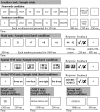Broad domain generality in focal regions of frontal and parietal cortex
- PMID: 24062451
- PMCID: PMC3799302
- DOI: 10.1073/pnas.1315235110
Broad domain generality in focal regions of frontal and parietal cortex
Abstract
Unlike brain regions that respond selectively to specific kinds of information content, a number of frontal and parietal regions are thought to be domain- and process-general: that is, active during a wide variety of demanding cognitive tasks. However, most previous evidence for this functional generality in humans comes from methods that overestimate activation overlap across tasks. Here we present functional MRI evidence from single-subject analyses for broad functional generality of a specific set of brain regions: the same sets of voxels are engaged across tasks ranging from arithmetic to storing information in working memory, to inhibiting irrelevant information. These regions have a specific topography, often lying directly adjacent to domain-specific regions. Thus, in addition to domain-specific brain regions tailored to solve particular problems of longstanding importance to our species, the human brain also contains a set of functionally general regions that plausibly endow us with the cognitive flexibility necessary to solve novel problems.
Keywords: Multiple-demand system; cognitive control.
Conflict of interest statement
The authors declare no conflict of interest.
Figures



Similar articles
-
Dynamic Trial-by-Trial Recoding of Task-Set Representations in the Frontoparietal Cortex Mediates Behavioral Flexibility.J Neurosci. 2017 Nov 8;37(45):11037-11050. doi: 10.1523/JNEUROSCI.0935-17.2017. Epub 2017 Oct 2. J Neurosci. 2017. PMID: 28972126 Free PMC article.
-
Numerical ordering and symbolic arithmetic share frontal and parietal circuits in the right hemisphere.Neuroimage. 2014 Jan 1;84:786-95. doi: 10.1016/j.neuroimage.2013.09.037. Epub 2013 Sep 21. Neuroimage. 2014. PMID: 24064069
-
Abnormal parietal cortex activation during working memory in schizophrenia: verbal phonological coding disturbances versus domain-general executive dysfunction.Am J Psychiatry. 2007 Jul;164(7):1090-8. doi: 10.1176/ajp.2007.164.7.1090. Am J Psychiatry. 2007. PMID: 17606661
-
Parietal cortex and spatial cognition.Behav Brain Res. 2009 Sep 14;202(2):153-61. doi: 10.1016/j.bbr.2009.03.012. Epub 2009 Mar 19. Behav Brain Res. 2009. PMID: 19463696 Review.
-
The multiple-demand (MD) system of the primate brain: mental programs for intelligent behaviour.Trends Cogn Sci. 2010 Apr;14(4):172-9. doi: 10.1016/j.tics.2010.01.004. Epub 2010 Feb 18. Trends Cogn Sci. 2010. PMID: 20171926 Review.
Cited by
-
A possible functional localizer for identifying brain regions sensitive to sentence-level prosody.Lang Cogn Neurosci. 2015;30(1-2):120-148. doi: 10.1080/01690965.2013.861917. Lang Cogn Neurosci. 2015. PMID: 25642425 Free PMC article.
-
GABAergic inhibition in human hMT+ predicts visuo-spatial intelligence mediated through the frontal cortex.Elife. 2024 Oct 1;13:RP97545. doi: 10.7554/eLife.97545. Elife. 2024. PMID: 39352734 Free PMC article.
-
Executive function in systemic arterial hypertension: A systematic review.Dement Neuropsychol. 2019 Jul-Sep;13(3):284-292. doi: 10.1590/1980-57642018dn13-030004. Dement Neuropsychol. 2019. PMID: 31555400 Free PMC article.
-
Recursive hierarchical embedding in vision is impaired by posterior middle temporal gyrus lesions.Brain. 2019 Oct 1;142(10):3217-3229. doi: 10.1093/brain/awz242. Brain. 2019. PMID: 31560064 Free PMC article.
-
Speech Registration in Symptomatic Memory Impairment.Front Aging Neurosci. 2018 Jul 9;10:201. doi: 10.3389/fnagi.2018.00201. eCollection 2018. Front Aging Neurosci. 2018. PMID: 30038566 Free PMC article.
References
-
- Cabeza R, Nyberg L. Imaging cognition II: An empirical review of 275 PET and fMRI studies. J Cogn Neurosci. 2000;12(1):1–47. - PubMed
-
- Duncan J. The multiple-demand (MD) system of the primate brain: Mental programs for intelligent behaviour. Trends Cogn Sci. 2010;14(4):172–179. - PubMed
-
- Cole MW, Schneider W. The cognitive control network: Integrated cortical regions with dissociable functions. Neuroimage. 2007;37(1):343–360. - PubMed
Publication types
MeSH terms
Grants and funding
LinkOut - more resources
Full Text Sources
Other Literature Sources

